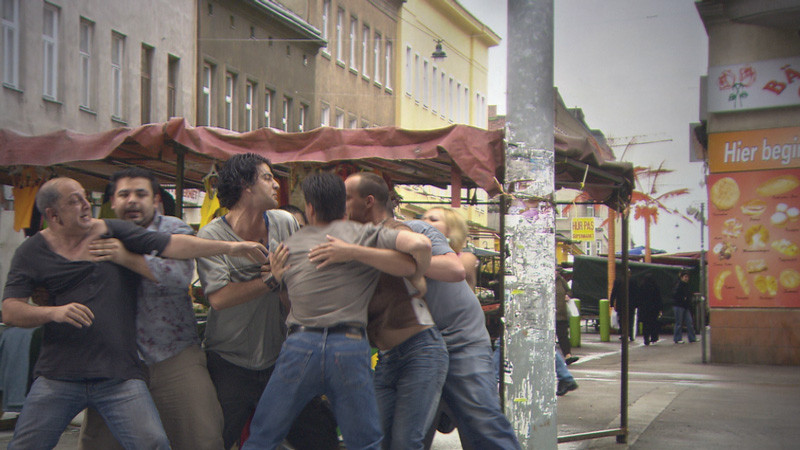[Fall 2009]
June 7 to November 22, 2009
The constellation of temporary exhibitions, national representations, and thematic exhibitions that take over Venice for the first week of June every other year is usually a grand affair that defies any type of human scale. Surprisingly, that was largely untrue this year. Perhaps as a side effect of the slowing world economy, the majority of artworks and exhibitions seemed less glittery and over the top. This new-found seriousness at the Venice Biennale ultimately allowed a good number of interesting, intelligent, and compelling artworks to stand out without reverting to the shock-and-awe treatment of previous years. Within the realm of photography and video-based art, three artists’ works are particularly worth a second look: those of Mark Lewis (Canada), Atta Kim (Korea), and Fiona Tan (Holland). Though each is quite different in content, all shared a simplistic and somewhat subdued approach that successfully embodied very powerful artistic voices.
Mark Lewis’s exhibition in the Canadian pavilion (Cold Morning, in the giardini) consists of four video projections presented linearly on the only gallery wall. Contrary to most contemporary video projections, Lewis has opted to keep his four screens relatively small (the largest being three by four feet). The subjects vary from a homeless person tidying up his living environment (a subway grate at a busy city intersection in the middle of the Canadian winter) to a mixed-ethnicity couple playfully skating on the Nathan Phillips Square rink and an awkward street fight in a working-class street market. Linking these seemingly diverse videos is the artist’s interest in the dislocation between subject and object, between human interactions and the built environment in which they occur. To render that dislocation tangible (and at times disquieting), Lewis reverted to the 1950s Hollywood technique of rear-projecting fake backgrounds in two of these works. The end result is videos that appear rather straight-forward, and perhaps even uninteresting, until your eye starts stuttering at the seam between subject and object. That seam separates not only subjects and object but also viewers and context. From an art-fuelled walk in the Biennale giardini, visitors end up atop a philosophical cliff, looking down at their living environment with an unshakable sense that it is all slightly ill-designed props.
The off-giardini Korean pavilion (in Dorsoduro) also presented an exhibition that shied away from glitz and grandiose gestures. This exhibition, by Atta Kim, was launched with a performance involving a smallish group of international art critics and curators, a manicured garden, classical arias, an artist standing atop a construction platform draped with red fabric, and about half a dozen people exercising, praying, or aimlessly walking in circles apparently completely oblivious to their surroundings. The performance culminated in Kim, and his construction platform, reaching a height of approximately 25 feet, at which point he graciously threw down some ten thousand snapshots of Rome printed on very thin rice paper. These images were the constituent parts of a photographic work on display in a space close by. For this cumulative image of Rome from Kim’s series On Air, as well as for the other three cities included in this body of works, the artist superimposed ten thousand snapshots of the selected city in an attempt to incorporate as much as possible of urban daily life into a single frame. When printed as single large-scale works, these compendiums ultimately became flat gray rectangles. The framed surfaces, just like projection screens of olden days, encouraged individual viewers to superimpose onto them their own memories and visions of the cities referred to in the titles. In another group of works from the same series, Kim used extra-long exposures (six to eight hours) to, again, transform all human activity into poetic traces. These vanishing acts seemed to suggest that stability exists only in objects and is inherently opposed to human fleeting presences. Could this opposition also be at the heart of the discomfort between subject and object in Lewis’s work?
Another work in the 2009 Venice Biennale also subtly, yet powerfully, encouraged viewers to reflect on the distance between subjects and objects. In Fiona Tan’s Disorient (Dutch pavilion), a slow-moving camera that alternates between views of an Asian curiosity shop/cabinet and scenes of utter poverty in Asia is pitted against a soothing and heartfelt male voice reading excerpts of Marco Polo’s journals about the Orient. Though at first the voice and images seem to fit rather well, one quickly discovers the huge gap separating the two; Marco Polo’s journal is a fantastic work that describes imaginary beasts, people, and places that have no connection to the Asian images being shown. Simply put, Marco Polo is making up and projecting an imaginary Orient upon which Tan is forcing moving images that relentlessly topple the spoken words. Tan’s screen is much busier than Kim’s silvery screens, yet in both cases the artistic process exposes the chasm separating subject and object.
Ultimately, the dislocation between Marco Polo’s subject and the projected images is so great that they make each other seem unreal, just occurs with Lewis’s rear projections and Kim’s vanishing act. There is a strong impression of disorientation, eeriness, and dislocation at the heart of these works. But they are of a subdued type that usually does not fare well when juxtaposed with glittery, flashy, noisy works of contemporary art. Since it is the relative quietness and seriousness of the 53rd Venice Biennale that allowed them to shine through, I dare to hope that future instalments of this contemporary art event will retain some of this newly acquired maturity.
Jean-François Bélisle is the director of the Contemporary Art Galleries Association (AGAC), as well as an independent curator and critic. He has researched and written about the Venice Biennale since 2003.



